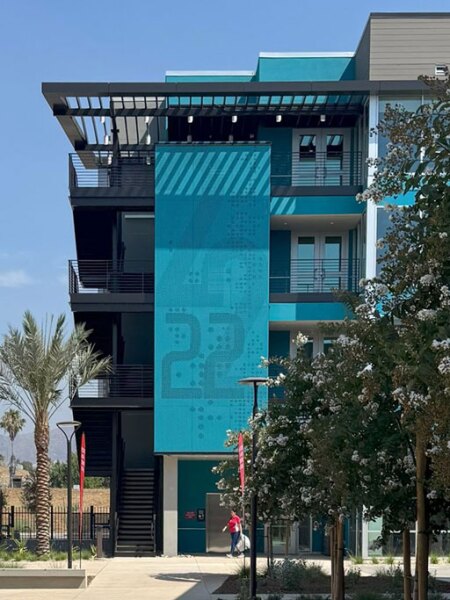
The scarcity of on-campus housing—especially affordable housing—means many students have little choice but to forgo the convenience, economy, and other benefits of campus life. Now, California State University, Northridge (CSUN) has become the first in the CSU system to address this disparity by adding new on-campus housing that is both affordable and can be quickly replicated across the entire system to bolster its on-campus populations.
On-campus living is considered a foundational part of the college experience, and at nearly $13,804 a year in the California State University (CSU) system, it’s usually cheaper than living off campus. But the scarcity of on-campus housing—especially affordable housing—means many students have little choice but to forgo the convenience, economy, and other benefits of campus life. Now, California State University, Northridge (CSUN) has become the first in the CSU system to address this disparity by adding new on-campus housing that is both affordable and can be quickly replicated across the entire system to bolster its on-campus populations.
Completed in August 2025, these two pilot projects—Hibiscus Hall and Joshua Tree Hall—provide nearly 200 beds at a reduced rate from CSUN’s standard housing. The $72.9M million project, part of CSUN’s Freshman Student Housing Phase III, was funded through the Statewide Lease Revenue Bond (SB 155), which dedicated $201 million to the CSU general fund to support new student housing, and another $37.5 million from the California Higher Education Student Housing Grant Program.
Developing CSUN’s new on-campus housing presented a unique challenge for construction firm C.W. Driver Companies, which has a robust portfolio of education projects across Southern California, including four previous builds at CSUN. With a mandate to quickly deliver a replicable housing prototype, the company turned to the university’s previous housing plans in designing the new complex.
“Collaborating with C.W. Driver and the entire team was a great partnership,” says Kevin Conn, CSUN’s executive director for Student Housing and Residential Life. “We have worked closely to review and address challenges as they arose, ensuring that the needs of both our facilities and student population were effectively met.”
The vision
The vision for the project was not overly complex. Both Hibiscus Hall and Joshua Tree Hall are four stories tall, collectively providing 198 beds. Besides fulfilling essential dormitory functions, Joshua Tree Hall also offers community space, study rooms, and a large multipurpose room, while Hibiscus Hall houses administrative offices for housing operations, mail services, and additional gathering spaces.
Most notably, both buildings are woven into the CSUN campus through a vibrant courtyard. The 19,000-square-foot (1,765 sq m) plaza connects to student housing offices, a food service complex, and outdoor dining. A permanent photovoltaic canopy provides shade, while oversized ceiling fans and a large outdoor TV are conducive to hosting movies and watching sports.
The large open space was designed to help students easily navigate the CSUN campus and all of its many functions, while providing ample opportunities to connect with other students. It is also emblematic of Southern California, where consistently warm temperatures allow students to spend time outdoors day or night.

The CSUN project team including staff from C.W. Driver from left to right: Anna Karapetyan, assistant project manager; Raymond Zadoorian, project engineer; Bill Blasey, project manager; Brent Hughes, COO; Jeff Hall, senior project manager; John Kately, project executive; and Colin Donahue, vice president, Administration and Finance for CSUN and Ken Rosenthal, associate vice president, Facilities Development & Operations for CSUN.
Prioritizing sustainability
Both Joshua Tree Hall and Hibiscus Hall have been awarded LEED Gold certification, which embodies high indoor air quality, wellness spaces, controlled lighting, power-generated key card access, and thermal comfort controls, among other green features. In this way, CSUN is helping pave the way for the entire CSU system—23 distinct campuses across the state—to achieve optimal sustainability metrics over the next 20 years. By 2040, CSU aims to reduce greenhouse gas emissions by 80 percent from 1990 levels—and achieve carbon neutrality by 2045.
While achieving sustainability often comes with higher upfront costs, the differences are ultimately negligible. In fact, green features can offset construction costs through lower utility bills, reduced maintenance and repairs, increased asset value, and financial incentives that encourage long-term commitments to the environment. Those savings can then be put into even more student housing projects with even faster timelines.
Assessing the prototype

Completed in August 2025, these two pilot projects—Hibiscus Hall and Joshua Tree Hall—provide nearly 200 beds at a reduced rate from CSUN’s standard housing. The $72.9M million project, part of CSUN’s Freshman Student Housing Phase III, was funded through the Statewide Lease Revenue Bond (SB 155), which dedicated $201 million to the CSU general fund to support new student housing, and another $37.5 million from the California Higher Education Student Housing Grant Program.
Hibiscus Hall and Joshua Tree Hall were not just another student housing project. C.W. Driver Companies intended them as models that can be quickly replicated on campuses across the country, underscoring the importance of builders and universities collaborating to support such projects. Here are some valuable lessons from the CSUN project that can be executed elsewhere:
- Leverage previous designs that have worked to support timeliness: Students need affordable housing fast, and past successes in this area are a valuable resource for universities, designers, and builders. Construction times can be trimmed by up to 30 percent if design and preconstruction are based on proven existing models.
- Understand the evolving needs of the client: Universities are always looking to develop student housing that is both affordable and an extension of the university’s culture. By assessing the immediate needs of CSUN’s growing student population, as well as CSU’s overall sustainability goals, the new housing complex meets the need for increased security, yet also provides easy campus connection to essential buildings and incorporates many green features that support the whole CSU system.
- Staying ahead of student housing trends: It’s essential for builders to stay ahead of student housing trends so they can make thoughtful recommendations and produce functional, sustainable structures that enhance campus life.
Through C.W. Driver Companies’ longstanding relationship with CSUN, the construction of Hibiscus Hall and Joshua Tree Hall put student safety and ease of navigation as top priorities, with both buildings featuring updated security systems, a central elevator, and building services. Students are able to move freely about the complex without cumbersome obstacles, showing that safe, sustainable, and affordable student housing can be welcome additions on today’s campuses.
